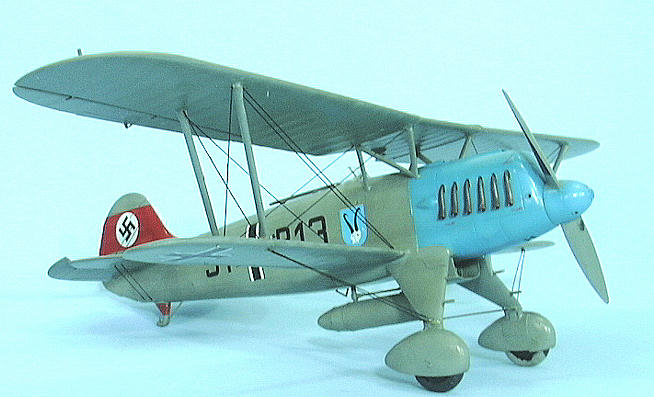
Silver Wings 1/32 He-51
| KIT #: | 32-001 |
| PRICE: | Around $150.00 |
| DECALS: | Two options |
| REVIEWER: | Tom Cleaver |
| NOTES: | Full Resin kit |

| HISTORY |
There is a saying in aviation design that, "if it looks right, it is
right." While this is generally
true, it was unfortunately not the case as regards the Heinkel He-51, which was
a completely orthodox biplane of undistinguished performance, though this was
primarily due to the failure of the German aircraft industry of the period to
develop suitable high-performance engines as was happening in Great Britain at
Rolls-Royce. Had the He-51 been
powered by a Kestrel, like its contemporary the Hawker Fury, things might have
been different, even if it was nowhere near as maneuverable as that famous
classic. Its lack of maneuverability can be laid completely at the feet of the
designers, who gave it the longest wingspan of any biplane fighter of the 1930s.
Given that the biplane design hung on in fighters because it allowed a
designer to minimize wingspan to increase roll rate while maintaining wing area,
this design fault is the likely cause of the He-51's failure as an effective air
superiority fighter.
What was important about the He-51 from a design standpoint was its
elegance of line, being the first design to come from the aesthetic of designer
Walter Gunter; complemented by the mathema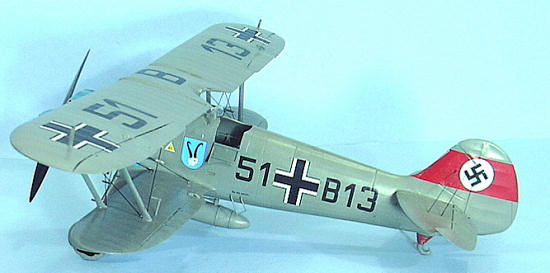 tic
genius of his twin brother Siegfried, these two would provide the indelible
hallmark "look" of Heinkel aircraft of the Thirties.
tic
genius of his twin brother Siegfried, these two would provide the indelible
hallmark "look" of Heinkel aircraft of the Thirties.
The airplane first appeared as the He-51a.
The Technischen Amt of the Luftfahrtkommisariat became
interested when it was revealed it had a higher performance than the Arado
Ar-65E which was planned as the first fighter equipment of the still-secret
Luftwaffe, with the same BMW 6.0 ZU engine; this fighter promised performance
that would equal the international standard.
Introduced into service as the He-51A-0, the fighter equipped the DVL
Reklame-Staffel Mitteldeutschland, the "
The He-51B differed from its predecessor in having twin-wire bracing of
the landing gear, and the ability to carry a 50-liter drop tank beneath the
fuselage. As production
proliferated in 1936-37, so did the number of Jagdgeschwader mounted on
the elegant-looking fighter, with their colorful unit markings.
The He-51 first saw “combat” during the re-occupation of the
The beginning of the end for the He-51 came in January 1936.
The Luftwaffefuhrungsstab considered that the Arado Ar-68 offered
little over the Heinkel in terms of performance and questioned putting it into
production. Ernst Udet, Inspector of Fighter and Dive Bomber Pilots, decided to
resolve the question. Mounted in
the Ar-68E, with a very experienced pilot in an He-51, Udet out-climbed,
out-dove and out-maneuvered the Heinkel fighter with ease.
By this point, however, the He-51 was in full-scale production, and
because of the publicity surrounding it as the Luftwaffe’s first fighter, it was
deemed politically imprudent to stop production and let the world know of the
airplane’s shortcomings.
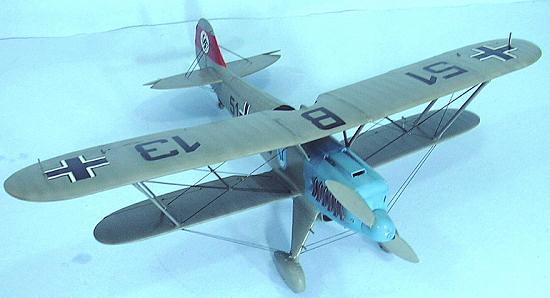 Later that year, in response to requests from General Francisco Franco,
Hitler decided to provide support to the Nationalists in what was developing
into the Spanish Civil War. Six
He-51s were sent to
Later that year, in response to requests from General Francisco Franco,
Hitler decided to provide support to the Nationalists in what was developing
into the Spanish Civil War. Six
He-51s were sent to
In retrospect, the failure of the He-51 was ultimately a good thing for
the Luftwaffe, since it forced the service to bring the Messerschmitt
Bf-109 into production and operational use far earlier than would otherwise have
been the case, subjecting that great design to the pressure of wartime
development from the beginning of its career, and assuring it of the ascendancy
it would hold when war finally broke out in Europe three years later. As well,
the early introduction of the Bf-109 into combat forced the pilots of the
Luftwaffe to abandon the useless formations and tactics of the biplane era,
and create tactics and formations appropriate to a high-speed fighter; this
would mean they could outfly their enemies for at least the first two years of
the Second World War, since their opponents still used the outmoded tactics.
| THE KIT |
The He-51 first appeared as a kit in the early 1970s, when Hasegawa
released their 1/72 model; this can still be found, and it makes up into a very
nice model with a bit of work to create a cockpit interior.
In 1996, Classic Airframes released their first kit of the He-51, a
limited-run kit to be followed in 2008 by a later release featuring better
molding technology. This He-51 from
Silver Wings is the first kit of this airplane in 1/32 scale.
The kit is all resin, and is of the highest quality.
Wojciech Kulakowski is the designer of the Montex Fury Mk.I, the Hs-123
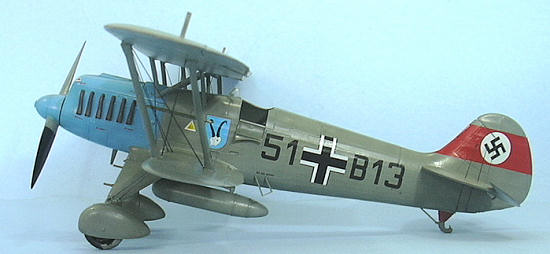 and the
Yak-1b, which are among the very best all-resin kits released and are the best
kits of these aircraft available in any scale.
With the release of this He-51, he has outdone himself.
The fuselage halves are molded so thin, and the other parts are of such
quality, that you could easily mistake the kit for an injection-molded kit from
a mainstream company like Hasegawa or Tamiya.
and the
Yak-1b, which are among the very best all-resin kits released and are the best
kits of these aircraft available in any scale.
With the release of this He-51, he has outdone himself.
The fuselage halves are molded so thin, and the other parts are of such
quality, that you could easily mistake the kit for an injection-molded kit from
a mainstream company like Hasegawa or Tamiya.
The cockpit is fully detailed, and lacks only seat belts, a problem
easily solved by the use of Eduard’s 1/32 photoetch Luftwaffe seatbelts. The
surface detail is crisp and subtle.
All control surfaces are separate, so the model can be posed dynamically
Fit of the parts is as good as I found in the Montex Yak-1b (surprise
surprise) and there do not appear to be any nasty surprises awaiting the modeler
when construction begins. I
particularly like that the cabane struts and interplane struts are cast with
wire cores, which will give them strength while providing better parts than were
available with the white metal struts in the Fury Mk.I kit.
Decals are provided for a He-51B-1 operated by 3./JG 223 at Wien-Aspern
in 1938, and an He-51B-2 operated by the Legion Condor in
| CONSTRUCTION |
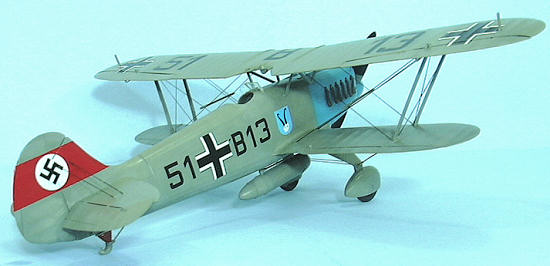 Construction of this model was as straightforward as would be the case
with anything from Tamiya or Hasegawa as regards fit.
I did need to use cyanoacrylate glue and Tamiya Surfacer on some of the
joints and the centerline seam, but overall this resin kit went together better
than any other I have done, including the Montex kits which are designed by the
same individual.
Construction of this model was as straightforward as would be the case
with anything from Tamiya or Hasegawa as regards fit.
I did need to use cyanoacrylate glue and Tamiya Surfacer on some of the
joints and the centerline seam, but overall this resin kit went together better
than any other I have done, including the Montex kits which are designed by the
same individual.
I began with the cockpit. I
first painted everything in RLM63 Light Grey-Green.
It is a little-known fact that between 1936-38, RLM02 was replaced by
RLM63, which was in turn replaced in 1938 by RLM02 again.
As to why this was, your guess is as good as mine.
I used Xtracrylix RLM63 for this.
Once everything was painted, I used seatbelts from the Eduard Bf-0109E-1
that I hadn’t used with that kit, and then assembled the cockpit per the
easy-to-follow instructions.
When the cockpit was finished, it was nice to discover it fit inside the
fuselage with no difficulty and no modifications.
I then glued the fuselage together and cleaned up the centerline seam.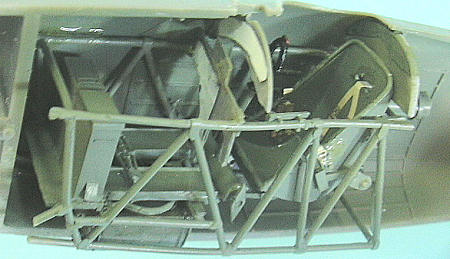
The horizontal stabilizers, rudder, elevators and landing gear all fit
easily. You can position the
control surfaces dynamically, but be sure to carefully test fit the ailerons and
flaps - you may Be very careful to get the dihedral of the wings right during
assembly. I found even with the
positive fit provided by the pegs, that I needed to fill the upper surface joins
with cyanoacrylate glue once they were in position.
The cabane struts fit easily.
Once these have set up, I suggest you tape the upper wing in position and
then attach the interplane struts to the lower wing so they are sure to fit in
the locating holes in the upper wing.
You can then remove the upper wing and proceed with painting.
I found I needed to use Evergreen rod for the steps on the landing gear
legs.
| COLORS & MARKINGS |
Painting:
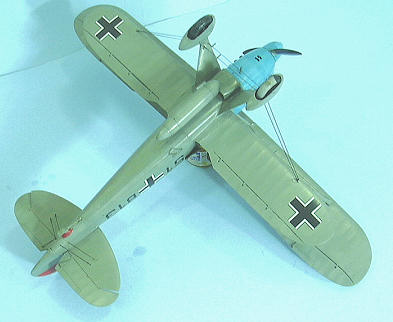
Decals:
The wing insignia provided in the kit decals is too large, or at least it is too large when compared with the few photos I could find of He-51s that showed the wings. Interestingly, the cross provided for the lower wing is the right size for the upper wing according to these photos, so I used that, and then used a smaller narrow-chord cross from a Bf-109E sheet for the lower wing. Other than this relatively minor glitch (which might not be a glitch if there are photos showing JG 223 using oversize insignia), the decals went on easily under a coat of Micro-Sol. While the kit provides the swastikas in pieces, I used full swastika decals from a Bf-109 sheet. I also used fuel markings and stencils from the Bf-109 sheet.
| FINAL CONSTRUCTION |
I gave the model an overall coat of Xtracrylix Satin Varnish, then attached the cockpit access step, the access hatch in the open position, and the windshield. I glued the “saxophone” exhausts in individually. I then painted the wheels. When this was done, I glued the upper wing in place which proved no problem, due to my having fit it previously. I finished off by rigging the model with .010 wire, painted black for artistic effect.
| CONCLUSIONS |
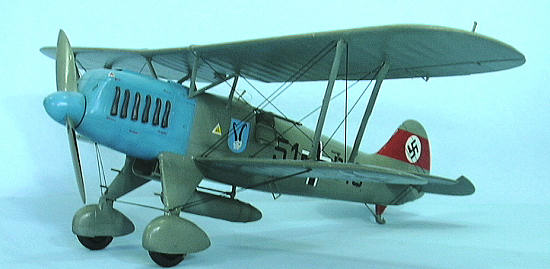 Despite its lack of performance, the He-51 is definitely one of the
best-looking biplane fighters ever made, and it epitomizes the early Luftwaffe.
The kit is a must-have for the serious modeler who is a fan of biplanes,
fighters of the 1930s, or the Luftwaffe (or all three!).
The kit does not present any problems for an experienced modeler who has
done both a few biplanes and a few all-resin kits; in fact, it is surprisingly
easy. With the kind of detail that
is here, the kit is well worth its admittedly-expensive price, since “it’s all
up there on the screen.” Highly
recommended.
Despite its lack of performance, the He-51 is definitely one of the
best-looking biplane fighters ever made, and it epitomizes the early Luftwaffe.
The kit is a must-have for the serious modeler who is a fan of biplanes,
fighters of the 1930s, or the Luftwaffe (or all three!).
The kit does not present any problems for an experienced modeler who has
done both a few biplanes and a few all-resin kits; in fact, it is surprisingly
easy. With the kind of detail that
is here, the kit is well worth its admittedly-expensive price, since “it’s all
up there on the screen.” Highly
recommended.
Thanks to Wojciech
Kulakowski at Silver Wings for the review kit.
July 2009
Thanks t
If you would like your product reviewed fairly and quickly, please contact me or see other details in the Note to Contributors.